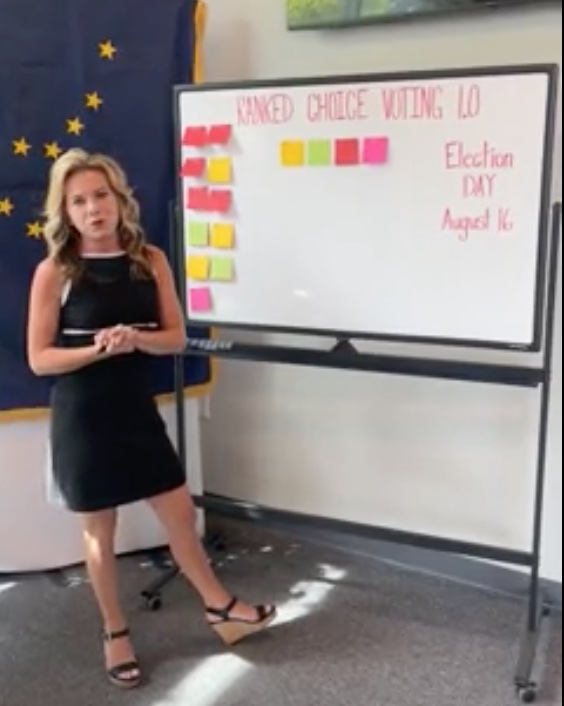The Division of Elections has just released its sample ballot for the Aug. 16 primary election that is combined with the Aug. 16 special general election for the temporary seat in Congress. The election ends in 48 days.
The statewide primary seats will be found at the top of the ballot — U.S. Senator, U.S. House, and Governor. Those are the “pick one” primary races.
The ballot explainer clarifies that anyone on the ballot can now claim to be a Republican, Democrat, or otherwise. Ballot Measure 2 stripped the ability of the registered Republicans, Libertarians or other parties in the state to nominate their own candidate with a separate ballot, available to their party members, nonpartisans, and undeclared votes. All candidates are now on one ballot.
The top four from the front side of the Aug. 16 ballot will proceed to the general election on Nov. 8, regardless of party affiliation. All four who are on the November ballot could be from just one party.
In some categories of the regular primary election, however, there are not four candidates running, and the ranked choice system is useless because all who are on the primary ballot will be automatically in the final four for the general election. This is true for almost all State House and Senate races.
In fact, only in state House District 35 are there 5 candidates, meaning one candidate will drop off for the November ballot.
The same is true for state Senate — no race has more than four candidates, so all will be on the November ballot for their district.
The top of the front page of the Aug. 16 ballot looks like this:

On the reverse side of the ballot voters will find the special general election, where they will rank from 1-4 their favorite candidates. This is another gift from Ballot Measure 2, brought to Alaska by Outside billionaire influencers in 2020.
Although the sample ballot shows that there will be four candidates, in fact there are only three candidates, after Al Gross dropped out of the race after the special election primary. This is another consequence of Ballot Measure 2. There will be no Libertarian candidate, nor a candidate from the Alaskan Independence Party. Only Republicans and Democrats will be on the ballot.
Voters also have the option of writing in a name and voting for that person.
On the real special general election ballot, the names are Nick Begich, Republican; Sarah Palin, Republican, and Mary Peltola, Democrat. The Division’s sample ballot shows “Favorite Natural Wonders of the World” as the example for how the ballot is laid out.

If you fill in more than one candidate’s bubble as your first choice, your ballot will be spoiled and will not count.
Once all ballots are received by Division of Elections, the tabulation machines will count the first page of the ballot using the regular method, and the second page of the ballot will go through the sorting process, whereby the candidate with the fewest first place votes is eliminated and their second choice moves up as their new first choice. The process continues until one candidate has more than 50% of the vote.

Learn about ranked choice voting and how the counting system works by watching a video demonstration of it by Americans for Prosperity-Alaska State Director Bernadette Wilson, at this link.

It’s a sham scam!
Grand Canyon all day! Great Barrier Reef is a commie! Niagra falls ain’t even from this country.
This is MGCGA country baby!
Good info on our corrupt new system. I guess I’ll never see the Alaska Independence party candidate again except on certain right leaning websites. I never heard a lick about their candidates from the mainstream media. Killing small party candidates was the purpose of this system?
Thank you Mike Porcaro. While I understand you made money promoting this abomination, the rest of us will pay for it.
I agree Oh Masked One. This mess is on Mike he promoted it big time on his talk show, which I no longer listen to.
At this moment there is at least one write in. Chris Bye
So if you vote for yourself first you will be eliminated first round as a write in making others second more important
Vote for both republicans first and second.
No write ins, no dumbocrats
What a scam election! The communists are winning.
Seems too be designed too confuse people! And then get their ballot tossed!
Much easier back in the day! For the voters?
Good thing we get a tutorial!!!! 101 on how to vote in Alaska!
Thank you!
Whenever there is no good option, write in Fred Ziffel
one man one vote; show id; manual counting like it was.
Can the Legislature put a stake through this abomination at the next session?
This is totally FUBAR!
Guesses on how many will vote wrong and void their ballot?
No “dark money”! (bull—-)
No mean tweets!
Lisa is a “conservative!
We are up to our waists in corrupt political quicksand.
Is there time before November to stop MAIL IN deep state voting ?
Say what you will about the limitations of Alaska’s previous way of doing elections, but it did not create six month periods of time when Alaska is without a voice in the United States House of Representatives. Remember, this doesn’t just happen when an incumbent dies. This delay is a feature of the new system and will pop up again anytime Alaska’s representative resigns from office, is appointed to a federal position, etc. Ever hear the phrase “No taxation without representation”? It’s making a comeback.
For all the fanfare that was made about empowering the people, under Ballot Measure 2, Alaskans will be left with fewer options on Election Day. Before, a third-party candidate could request and be permitted to take part in the debates. That option is now off the table. Why allow an AIP candidate to take the stage when their name won’t even be on the ballot?
Name ID is now the name of the game in more ways than it ever has been. If your name is recognized, that’s probably enough (interestingly enough, even if it’s recognized for less than stellar reasons). This is because some of the most attractive benefits of ranked-choice voting presume that when voters enter the voting booth they will know something about each of the candidates on the ballot; at least enough to be able to rank them.
But how many Alaskans know the name of their two state legislators?
Those were just the winners.
How many Alaskans will enter the voting booth knowing the names of each of the candidates for those positions?
In all too many cases you’ll be lucky if a voter has a favorite and least favorite candidate for the offices further down the ballot. Candidates #2, #3? Voters will now be casting votes for even more candidates that they know little or nothing about.
But that is by design.
Someone will be elected. Your ballot won’t be able to be counted by hand, or audited using the normal process (the algorithm is too complicated for that). But you will be told someone won on round #3 or 4 or 5 (or whichever round # the algorithm stops on). And if was candidate #3 it may be someone that a lot of Alaskans don’t even recognize. And if someone asks if they voted for that person, the answer in a lot of cases will be “uh…I guess so.” And even if that candidate won with only 25% of the vote on round #3, they will be given credit for the whole enchilada.
Before, everyone had an equal shot at getting a voter’s vote. Write-in candidates could compete alongside other candidates on equal terms. Our state’s most senior elected official went to DC after running as a write-in.
But what happens when you look at the list of write-in candidates for office in November and want to rank a couple of them on your ranked-choice ballot? You can cast four votes….but only for the major party candidates. If you try to rank two of the write-in candidates in your top four they will tell you No-Can-Do.
Did they have to design the ballot that way? Nope.
Did Ballot Measure 2 require them too? Nope.
They just did it.
At the end of the process, some candidates will be elected. The primaries won’t matter (for almost all races), so there will be less voter engagement on those races in the primary, which will be acutely felt by candidates for offices further down the ballot, and candidates that start out the election cycle with less name ID or a more modest campaign war chest than the incumbent. Unfortunately, the hill will be a steeper climb for you if you find yourself or your favorite candidate in that position.
If you don’t like political parties, you may count ballot measure 2 as a victory. Just remember, political groups and parties are how a lot of information (and misinformation) gets circulated about candidates and issues. Less involvement by political parties doesn’t equate to voters gaining more and better information about candidates. I wish it did.
So, voters may not know all that much about the eventual winner on Election Night, but the winning politician will get more votes (when you include the non-first-choice votes) and they’ll call it a win for democracy. I love progress. (I just wish it had a stronger correlation with better outcomes for members of the public.)
Rock on David. This mess was created on purpose. Do not vote for the party that brought us CF.
Too bad the Dominion machines weren’t audited after the last general election.
Just write in the same name 4 times. No extra votes for second place.
Think this is confusing?
Wait until there is a referendum question on whether to returning to old-fashioned pick one voting and see how complicated the overly wealthy left can make the ballot.
Would be no surprise were the informational text would be printed only in Mandarin (which, liberals, is NOT a suburb of Washinton).
Looks like we got tutorial 102 from Rep. David Eastman!
Thank you!
Some special math here Starts with 12 ballots, but ends up tallying 13 One of the original green ballots gets counted twice once red once yellow
After rewatching it’s the original Pink vote that gets counted twice
“Once all ballots are received by Division of Elections, the tabulation machines will count the first page of the ballot using the regular method, and the second page of the ballot will go through the sorting process.”
The above quote says it all folks. The machines and the people running them is the problem! How in the hell does a voter trust a machine that can be manipulated by people possibly getting paid under the table to give an accurate accounting of the peoples choice? How is the State holding this whole operation accountable? Are the machines properly certified by the State? Who has access to the machines and is there oversight by party officials and State officials? I understand you can only fill in one bubble for your candidate, but what if you don’t fill in any other choices? Do they throw out your ballot?
What a scam!
WATCH the tutorial, no, it does not get tossed..